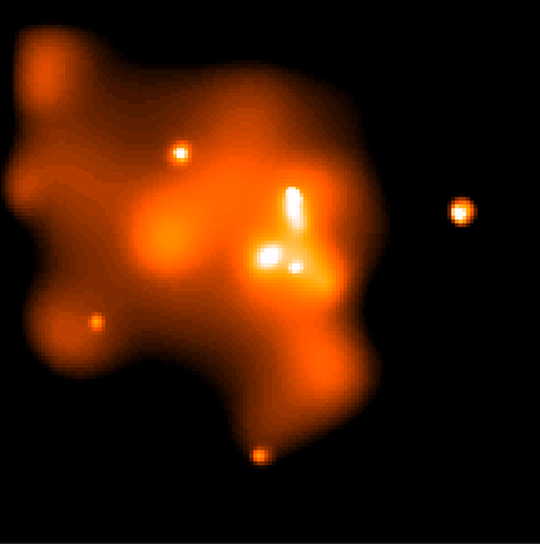
 Credit: NASA/MIT/PSU
Credit: NASA/MIT/PSU
The Nearest Supermassive Black Hole Found?
CHANDRA
PRESS RELEASE, JANUARY 14, 2000: Culminating 25 years of searching by
astronomers, researchers at the Massachusetts
Institute of Technology say that a faint X-ray source, newly detected
by NASA's Chandra X-ray
Observatory, may be the long-sought X-ray emission from a known
supermassive black hole at the center of our galaxy. This X-ray source is
the bright point at the center of the image above. The Chandra
image shows that this source is embedded in extended hot gas produced by
supernovae or stellar winds from massive stars, and is surrounded by other
point sources of X-ray emission. Frederick K. Baganoff and colleagues from
Pennsylvania State University, University
Park, and the University of California, Los
Angeles, presented their findings in Atlanta at the 195th national
meeting of the American Astronomical Society. Baganoff, lead scientist for
the Chandra X-ray Observatory's Advanced
CCD Imaging Spectrometer (ACIS) team's "Sagittarius A* and the
Galactic Center" project and postdoctoral research associate at MIT,
said that the precise positional coincidence between the new X-ray source
and the radio position of a long-known source called Sagittarius A*
"encourages us to believe that the two are the same." Sagittarius A* is a
point-like, variable radio source at the center of our galaxy. It looks
like a faint quasar
and is believed to be powered by gaseous matter falling into a supermassive
black hole with 2.6 million times the mass of our sun. Chandra's
remarkable detection of this X-ray source has placed astronomers within a
couple of years of a coveted prize: measuring the spectrum of energy
produced by Sagittarius A* to determine in detail how the supermassive
black hole that powers it works. But now that an X-ray source close to
Sagittarius A* has been found, it has taken researchers by surprise by
being much fainter than expected. "The luminosity of the X-ray source we
have discovered already is a factor of five fainter than previously
thought, based on observations from an earlier X-ray satelllite," Baganoff
said. Sagittarius A*, which stands out on a radio map as a bright dot, was
detected at the dynamical center of the Milky Way galaxy by radio
telescopes in 1974. Optical telescopes such as the Hubble Space Telescope
cannot see the center of our galaxy, which is enshrouded in thick clouds of
dust and gas in the plane of the galaxy. However, hot gas and charged
particles moving at nearly the speed of light produce X-rays that penetrate
this shroud. Only a few months after its launch, Chandra
accomplished what no other optical or X-ray satellite was able to do:
separate the emissions from the surrounding hot gas and nearby compact
sources that prevented other satellites from detecting this new X-ray
source. Chandra's ACIS detector was conceived and developed for
NASA by Penn State University and MIT under the leadership of Penn State
Professor Gordon Garmire.
Last Week *
HEA Dictionary * Archive
* Search HEAPOW
* Education
Each week the HEASARC
brings you new, exciting and beautiful images from X-ray and Gamma ray
astronomy. Check back each week and be sure to check out the HEAPOW archive!
Page Author: Dr. Michael F.
Corcoran
Last modified June 14, 2001


